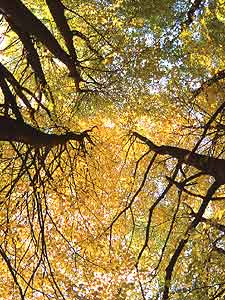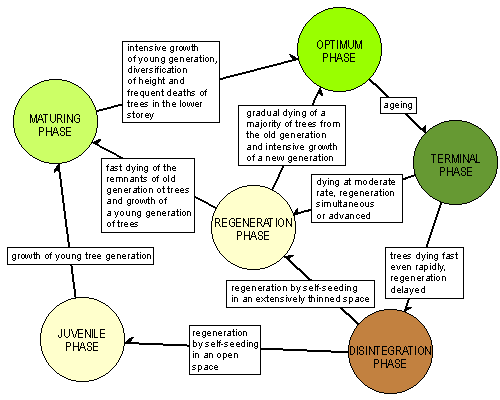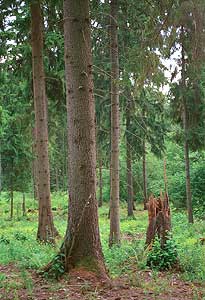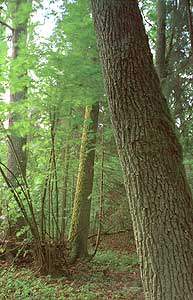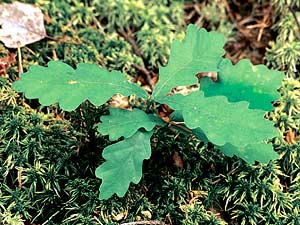|
FORESTS
|
|||||||||||
Text
|
Development phases of forest stands
In the Wigry National Park, around 60% of the forest ecosystems are in near-natural conditions. These forest stands, which are not commercially exploited, go through development phases which are of a repetitive cycle type. The driving force for the sequence of these phases are the inevitable processes of regeneration, growth, decline and death of both individual trees and entire forest stands. It is estimated that in the forests of the Park the whole cycle averages 300 years.
The scheme presented below explains the development phases of the Park’s forests using the Leibundgut method used by his school in forest sciences. The late Hans Leibundgut, who was Professor of Sylviculture in Zurich (Switzerland), created a system of development phases in forest stands, based on his studies of the natural mountain forests of the central parts of Europe. An attempt to introduce this system to lowland forests has been undertaken, taking a characteristic section of forest stand in the Bindasy natural oak-hornbeam wood site.
Optimum phase. A stand of variable age is composed of the following proportions of species: spruce 60%, common oak 20% and Scots pine 20%. Average age of trees – 120 years. The stands tends to achieve a one-storey structure, as the oldest, dominant trees slow down their rate of upward growth and are caught up in their development by slightly younger individuals. The number of trees is high and their trunk size is significant (some 40 cm of diameter at the breast height [dbh] – the diameter of a tree trunk 1.3 m above ground, i.e. at the breast height of adult man). Trees are viable, only some individuals die due to exclusion of light by taller neighbours.
Terminal phase (ageing). The majority of trees reach an age where their vitality deteriorates and some begin to die. For spruces, this process accelerates at around 140 years of age, for spruces – at 180 and more, whereas oaks remain much more viable and long-lived. The number of trees is much lower than in the optimum phase, but their average diameter is greater. The trees can reach 50 cm in dbh and 30 m in height. In thinned places and gaps there are first groups of self-seeding seedlings and denser understorey. These changes proceed slowly (the terminal phase is long-lasting – it may continue for over 50 years), and the acceleration of disintegration (dying) of the old stand and much more scattered self-seeding regeneration prove that the terminal phase is ending while either disintegration or regeneration phase follows.
Regeneration phase. The regeneration phase usually follows when moderate rate of dying among increasingly weakening trees of the old stand is accompanied by at least as speedy self-seeding from trees which are still viable. The number of trees of the old generation is low and continues to decrease still through individual deaths. The trees reach a very advanced age. For instance, the oldest pines growing in the Park are ca. 260 years old. In the regeneration phase, the number of trees in the undergrowth (young generation of trees which will later assume the role of the main stand) rises rapidly. At this stage the stand displays the most pronounced diversification into storeys, as it is composed of remaining trees of the old generation, some of the trees which represent the former storey immediately below the canopy level (canopy of a forest stand – crowns of the tallest forest trees). The younger generation of trees appear in clumps of various age, adding to the overall diversity. When almost all trees of the old generation die, the previous layer of sub-canopy trees, together with the young generation, catching up in terms of growth, are destined to become an optimum phase stand in future.
Disintegration phase (dying). If the death of a progressively weakened forest stand proceeds rapidly, the regeneration by self-seeding can be much delayed. Thus remnants of the old thinned stands, of variable sizes, are found, surrounded by extensive spaces of almost treeless land, covered by dense forbs and shrubs.
Juvenile phase. The juvenile phase follows the disintegration phase when the regeneration in the latter phase is still delayed and the remnants of the old generation are dying. After some years, when the environmental conditions in the space thus opened out become sufficiently suitable (vegetation cover is of crucial importance), side seeding (from nearby stands) occur by seeds of various species occurs, especially these having light seeds (birch, aspen, alder, pine). The juvenile phase is principally made of clumps of trees of various age (from year-old saplings to somewhat older trees standing up to about 2 metres). There are also spaces (gaps) still without any trees at all.
Maturing phase (initial). This develops either from the regeneration or juvenile phases and is a transitional stage to the optimum phase. The stand is made of tree clumps or groups of various age, derived from self-seeding during the regeneration phase or from seeding in open spaces during the juvenile phase. There may also be some groups of the youngest and most viable trees from the previous generation of forest – if any have survived. The trees in this stage are thin, up to 20 cm in dbh, but the rate of upward growth is the greatest of all stages. The differentiation into storeys can be noticed, and the weakest trees die in large numbers, as their growth is inhibited by stronger trees.
|
||||||||||
|
|
|
